Tripos Genera: The Giants of Dinoflagellates


Introduction to Dinoflagellates
Dinoflagellates are a fascinating group of microorganisms known for their unique characteristics and ecological significance. Within this diverse phylum, the Tripos genus stands out as one of the largest genera. Comprising numerous species, Tripos plays a pivotal role in marine ecosystems and serves as a vital component of the food web.
Characteristics of Tripos Species
Members of the Tripos genus are primarily characterized by their distinctive bioluminescent properties and armored plates. These organisms display a variety of shapes and sizes, often with intricate patterns on their cell membranes. The adaptations exhibited by Tripos species allow them to thrive in different marine environments, from coastal waters to open oceanic regions. The ability to photosynthesize enables some Tripos species to harness light energy, further contributing to their ecological success.
The Ecological Importance of Tripos
Tripos genera significantly impact marine food webs, serving as both primary producers and prey for various marine organisms. Their presence is often indicative of nutrient-rich waters, which support diverse marine life. Additionally, Tripos species can influence oceanic biogeochemical cycles, particularly through their role in carbon fixation and the turnover of marine nutrients. Understanding the dynamics of Tripos is essential for marine biologists studying ecosystem health and resilience against environmental changes.
The study of Tripos represents a crucial aspect of marine biology due to their complex interactions within marine ecosystems. As researchers continue to explore this fascinating group of dinoflagellates, it becomes increasingly clear that the Tripos genera hold significant ecological importance and offer insights into the health of ocean habitats.
